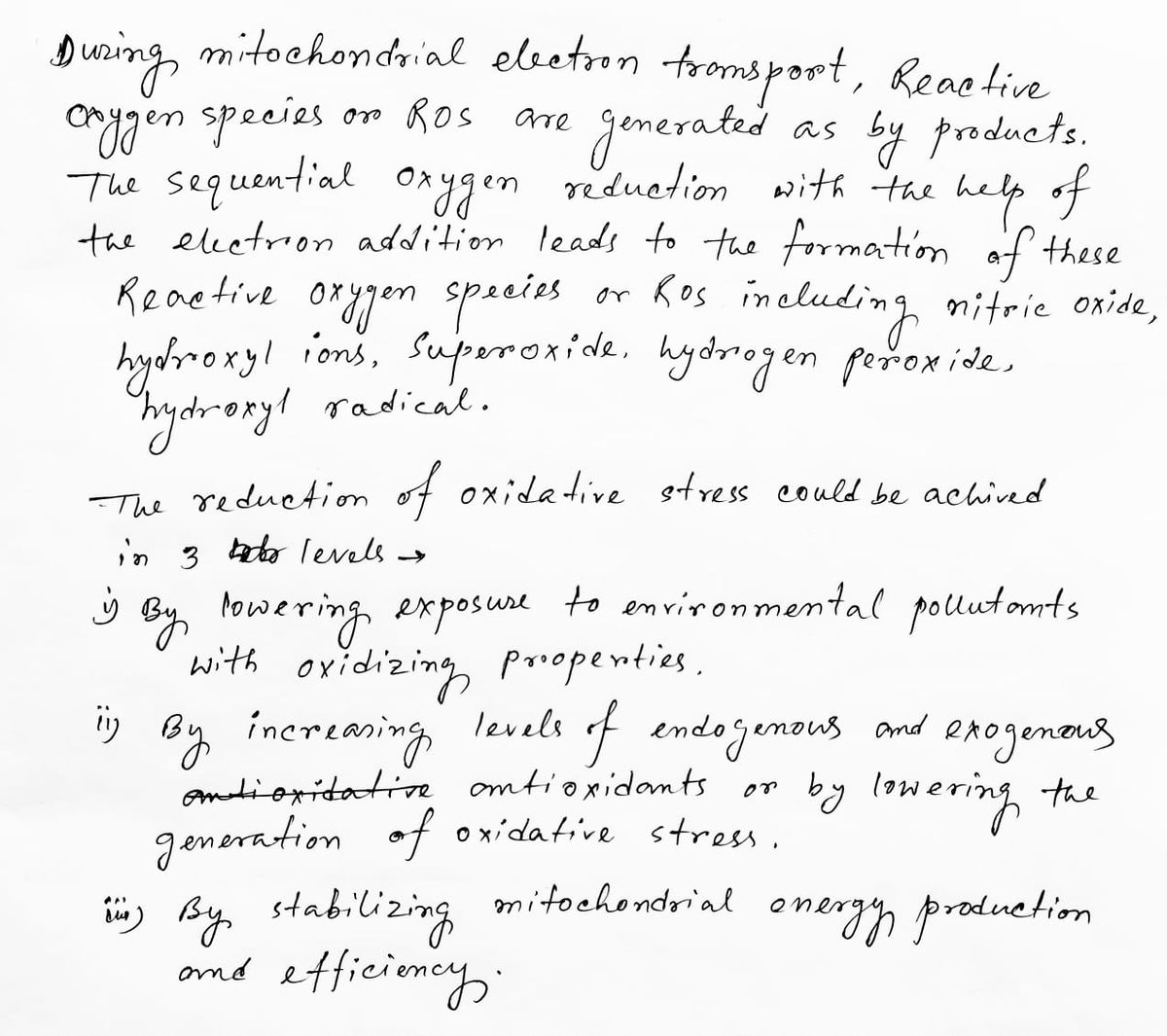Human Anatomy & Physiology (11th Edition)
11th Edition
ISBN:9780134580999
Author:Elaine N. Marieb, Katja N. Hoehn
Publisher:Elaine N. Marieb, Katja N. Hoehn
Chapter1: The Human Body: An Orientation
Section: Chapter Questions
Problem 1RQ: The correct sequence of levels forming the structural hierarchy is A. (a) organ, organ system,...
Related questions
Question

Transcribed Image Text:**Explain how reactive oxygen species are produced, controlled, and why they can be both good and bad in the body.**
Reactive oxygen species (ROS) are chemically reactive molecules containing oxygen. They are produced as natural byproducts of the normal metabolism of oxygen and have important roles in cell signaling and homeostasis.
**Production of Reactive Oxygen Species:**
1. **Mitochondrial Electron Transport Chain (ETC):** During aerobic respiration, the ETC in mitochondria generates ROS as electrons leak and partially reduce oxygen, forming superoxide.
2. **Enzymatic Reactions:** Enzymes such as NADPH oxidase, xanthine oxidase, and cytochrome P450 enzymes can produce ROS during metabolic processes.
3. **Environmental Factors:** Exposure to pollution, radiation, tobacco smoke, and other environmental stressors can increase ROS production.
**Control of Reactive Oxygen Species:**
1. **Antioxidant Enzymes:**
- **Superoxide Dismutase (SOD):** Converts superoxide radicals into hydrogen peroxide.
- **Catalase:** Breaks down hydrogen peroxide into water and oxygen.
- **Glutathione Peroxidase:** Reduces hydrogen peroxide and lipid peroxides with the help of glutathione.
2. **Non-Enzymatic Antioxidants:** Molecules like vitamin C, vitamin E, and glutathione neutralize ROS.
3. **Cellular Mechanisms:** Cells can upregulate antioxidant defenses in response to increased ROS levels through signaling pathways such as the Nrf2 pathway.
**Roles of Reactive Oxygen Species:**
- **Beneficial Roles:**
- **Cell Signaling:** ROS act as secondary messengers in signaling pathways that regulate processes like cell growth and immune responses.
- **Defense Mechanisms:** Immune cells produce ROS to destroy invading pathogens.
- **Harmful Effects:**
- **Oxidative Stress:** Excess ROS can damage DNA, proteins, and lipids, leading to cell death and contributing to diseases like cancer, cardiovascular diseases, and neurodegenerative disorders.
- **Inflammation:** ROS can promote inflammatory responses, exacerbating tissue damage.
In summary, while ROS play crucial roles in normal physiological functions and defense mechanisms, imbalances between ROS production and antioxidant defenses can lead to oxidative stress and associated pathologies. Proper regulation and balance are essential to harness their benefits and minimize harm.
Expert Solution
Step 1

Step by step
Solved in 2 steps with 2 images

Knowledge Booster
Learn more about
Need a deep-dive on the concept behind this application? Look no further. Learn more about this topic, biology and related others by exploring similar questions and additional content below.Recommended textbooks for you

Human Anatomy & Physiology (11th Edition)
Biology
ISBN:
9780134580999
Author:
Elaine N. Marieb, Katja N. Hoehn
Publisher:
PEARSON

Biology 2e
Biology
ISBN:
9781947172517
Author:
Matthew Douglas, Jung Choi, Mary Ann Clark
Publisher:
OpenStax

Anatomy & Physiology
Biology
ISBN:
9781259398629
Author:
McKinley, Michael P., O'loughlin, Valerie Dean, Bidle, Theresa Stouter
Publisher:
Mcgraw Hill Education,

Human Anatomy & Physiology (11th Edition)
Biology
ISBN:
9780134580999
Author:
Elaine N. Marieb, Katja N. Hoehn
Publisher:
PEARSON

Biology 2e
Biology
ISBN:
9781947172517
Author:
Matthew Douglas, Jung Choi, Mary Ann Clark
Publisher:
OpenStax

Anatomy & Physiology
Biology
ISBN:
9781259398629
Author:
McKinley, Michael P., O'loughlin, Valerie Dean, Bidle, Theresa Stouter
Publisher:
Mcgraw Hill Education,

Molecular Biology of the Cell (Sixth Edition)
Biology
ISBN:
9780815344322
Author:
Bruce Alberts, Alexander D. Johnson, Julian Lewis, David Morgan, Martin Raff, Keith Roberts, Peter Walter
Publisher:
W. W. Norton & Company

Laboratory Manual For Human Anatomy & Physiology
Biology
ISBN:
9781260159363
Author:
Martin, Terry R., Prentice-craver, Cynthia
Publisher:
McGraw-Hill Publishing Co.

Inquiry Into Life (16th Edition)
Biology
ISBN:
9781260231700
Author:
Sylvia S. Mader, Michael Windelspecht
Publisher:
McGraw Hill Education